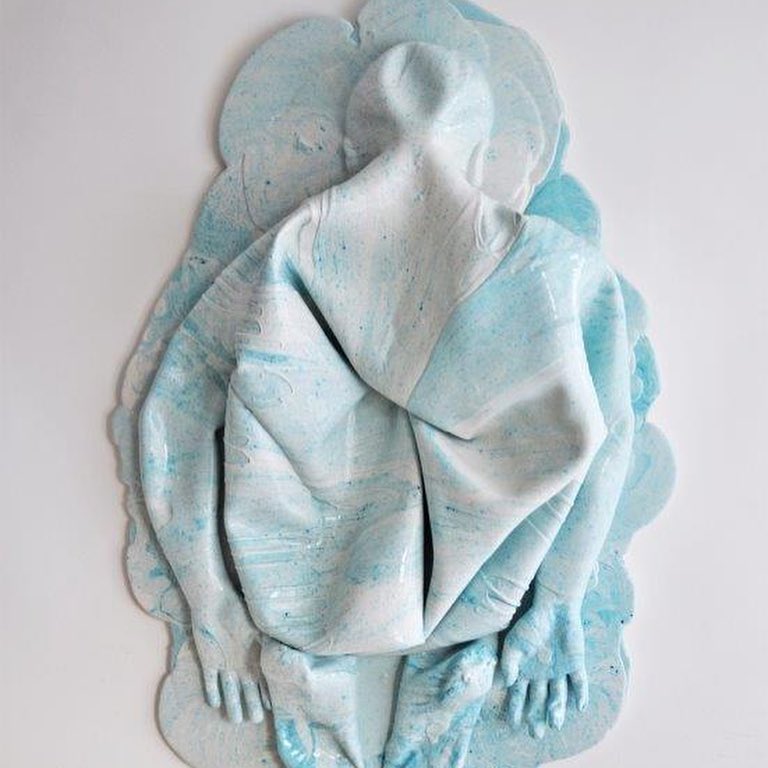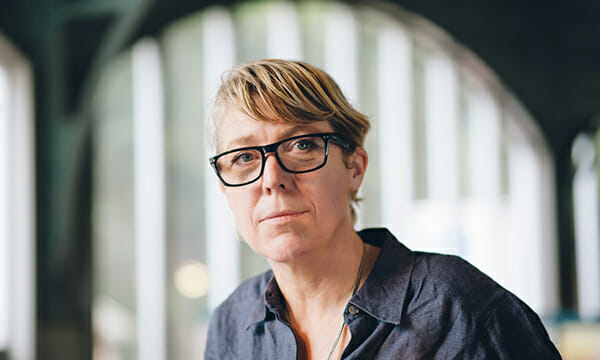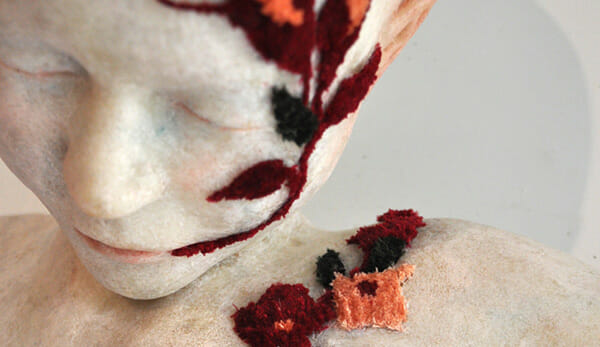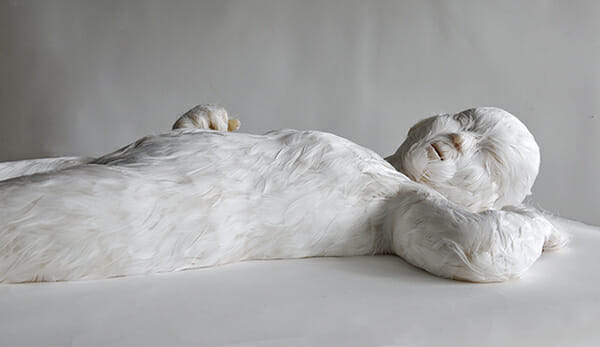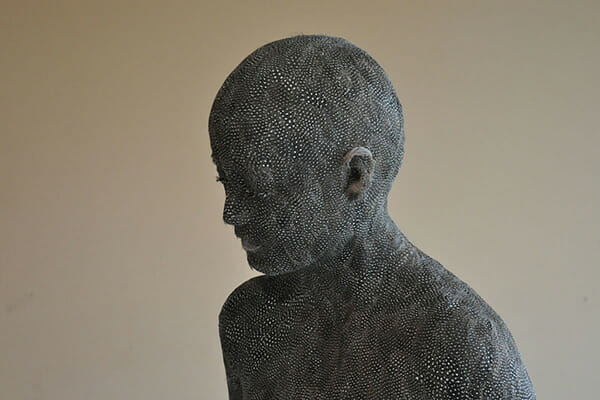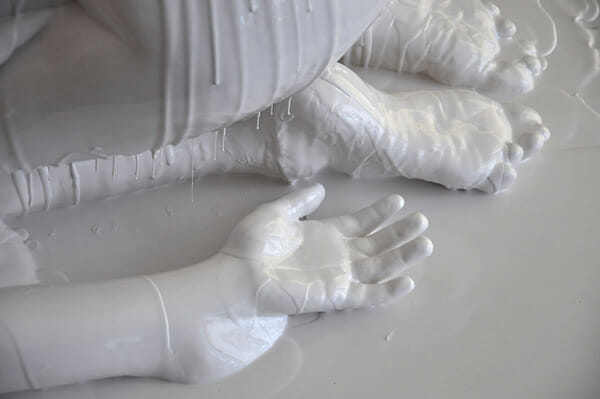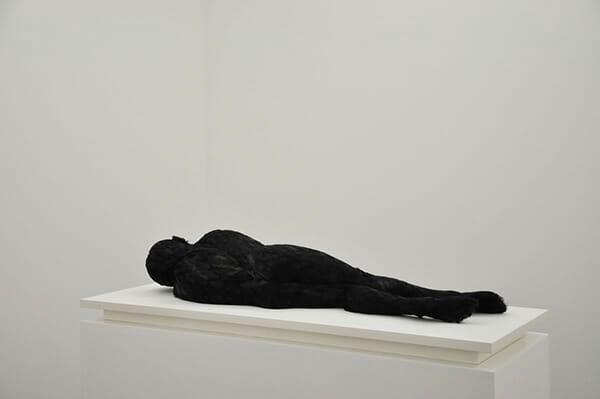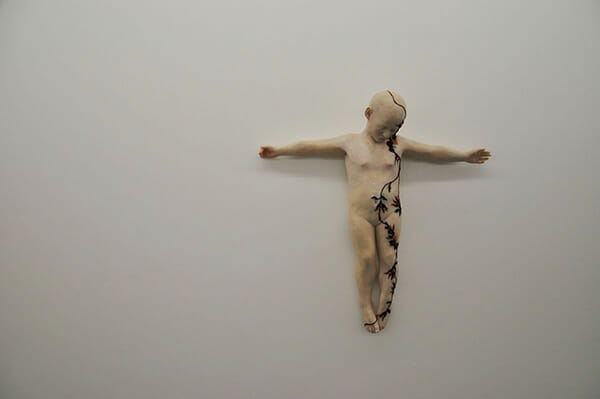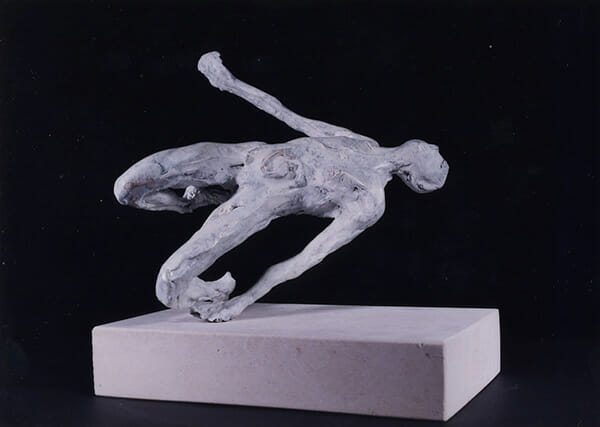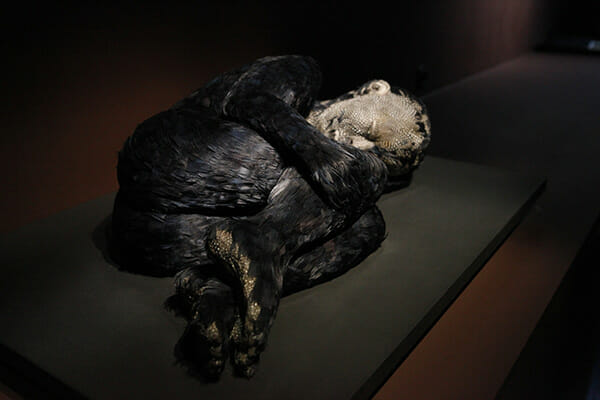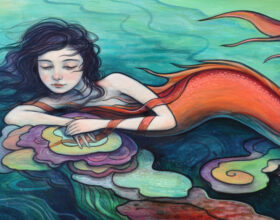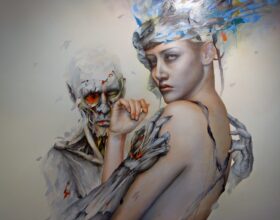In 1757, Edmund Burke expounded upon the idea of the sublime. He described the sublime as a pinnacle of emotion only sparked by creation, by art of any form. Lucy Glendinning’s work has been described as having this power; her sculptures compound a bevy of intricate concepts into a form that stuns with its quiet but direct nature.
The balance between beauty and darkness, human and animal, concept and design, is evocative. Known for her feathered children and surreal skin-suit like pieces, Lucy Glendinning was kind enough to sit down with Beautiful Bizarre Magazine and express the inner workings of her artist mind.
Interview conducted in conjunction with Lucy Glendinning’s editorial in Issue 21 of Beautiful Bizarre Magazine.
I have always been drawn to the figure; both my parents were doctors and my grandfathers surgeons. I spent a lot of time as a child looking at medical anatomy books and I still find the diagrams and illustrations fascinating. As time has progressed, the figures have become a vehicle to explore psychology and the human condition.
What has your artistic progression been? Can you describe the difference between your beginnings as an artist, to the artist you are now? How has your past enriched your present?
I have always been drawn to the figure; both my parents were doctors and my grandfathers surgeons. I spent a lot of time as a child looking at medical anatomy books and I still find the diagrams and illustrations fascinating. As time has progressed, the figures have become a vehicle to explore psychology and the human condition.
After college I worked in a bronze foundry for Elizabeth Frink making molds and waxes, a process, which has influenced my work ever since.
Why was sculpture the medium you felt most connected to? How do you choose which medium is best for an idea you have?
The physicality of the three dimensions is what I have always responded to and found the best vehicle to express ideas. I think we all have different levels of response to various mediums. I feel sculpture is my natural language.
I usually know which material I am going to use for a piece but sometimes it changes as the work progresses. I experiment with materials a lot but always come back to casting process. I am very interested in surface and use different materials to realize ideas. I use a lot of wax and rubber at the moment and I often experiment with casting different materials and using different surfaces.
The immediate thought I had when viewing your piece “Baby Jesus 2” was that in sacrificing nature and Planet Earth for our own selfish purposes, in the long term we sacrifice ourselves. Do you consider your work to be eco-conscience art? How do you feel about the advancements we’re making in science like cloning, stem cell research, etc.?
That’s interesting and great that the piece makes you think that. Yes, like most people I am eco-conscious and try and use materials, which have less impact, although it is a dichotomy when making objects.
I am currently looking at how to cast recycled plastic; it has not worked yet but when I have more time over the summer, I am hoping to be able to solve it. I am, of course, very concerned about the environment and the extinction of species the piece ‘the last bird’ is a reference to this.
I think the advancement of science is fascinating and wonderful, it will be life changing for a lot of people, and will cure some of the most destructive diseases and illnesses. I think genetic manipulation will change human kind’s future, and with the feather child series I am looking to ask the question, will we be able to resist enhancing our children. After we can cure diseases like cancers, will we ‘improve’ our species, in what ways will we do this and will that be for the better, who will decide and who will have access to these ‘improvements’.
I think this is probably inevitable, but I want to encourage discussions about it, it could produce an even large divide between the haves and have-nots.
What inspires or sparks your ideas for your artwork? Are there any films, books or artists that you continually turn to for motivation?
I love sci-fi movies; I like exploring possible futures with my work and love to see the thoughts and ideas people have in films. The first Blade Runner, Brazil and Dr Strangelove are old favourites for me; I loved the Arrival. I love lots of artists, I always come back to looking at Rodin, Kiki Smith, Louise Bourgeois, Berlinde De Bruyckere, Erwin Wurm, Maurizio Cattelan and Jaume Plensa, especially his marble heads which are amazing. I love books but read very slowly so am often drawn to poetry. I love Charles Bukowski and I read more factual book. I find Oliver Sacks fascinating.
I read that you start all of your series with poems, songs, and other written introductions. What is your process like, and how do you move from concept/the verbal, to the physical?
I often start with a phrase or poem, never a song. They are like shorthand to ideas, and though I have many more of these than are made into works, sometimes, they are specific to sculptures and sometimes they are atmospheres that lead to specific ideas for works.
Because your work is so entrenched with psychological and philosophical ideas, I am very curious to know what your personal life philosophy or belief system is and how it affects your artistic output?
I don’t think you can separate the two. I am an atheist; I think I am influenced by my medical upbringing and like to research my work a bit like a medical research but without the scientific restrictions or the need for proof. I am interested in how and why people experience what they do and the influence of our subconscious on our current experiences, and what we see.
I am concerned about our effect on the environment; overpopulation it is an uneasy time at the moment and a lot of the political decision made seem crazy. I am very worried and feel quite emotional about the UK leaving Europe. I think it is a decision made on fear, mistrust and frustration with the inequality of rich to poor here. I think it is a massive step backwards. I think of myself as a European.
I live with my husband, Mark Merer, who is a land-artist and also designs buildings and we have built studios and house. We have a small company called landhouse, which is in a small way trying to change housing development here in the UK as its currently very corporate and financially lead rarely involving any design or aesthetic and very little environmental consideration.
You’ve mentioned before in past interviews that your hope is that the audience will understand “in a brief moment” what the piece is trying to communicate. How do you make sure that your work is understandable through a multitude of perspectives? What do you hope the audience will walk away feeling or thinking?
I am not sure this is a full quote. I would like the person to be drawn to the work; I often use craft for this and hopefully evoke an emotional response. There is immediacy there but to understand it sometimes takes longer to explore and is, of course, always affected by their own perspective. I am hoping to create a question or a thought. I am not looking to answer questions, more to ask them.
I extremely admire that you often speak of the importance of art being accessible to everyone. What has your experience been as a female artist in an industry that still has a long way to go with inclusivity and equality? Why is it important to you that art be accessible?
Obviously, there is a long-standing inequality, but it is improving, and it is being voiced again now, which is wonderful. I have only knowingly, directly experienced inequality a few times only when my work has crossed over into the worlds of construction, fabrication and engineering. I have only been knowingly affected by it a couple of times which is probably lucky but it has been and is an underlying tide, which hopefully will keep changing. I think the arts are one of the most forward thinking of all the places to work by its nature. But by its nature the arts should lead the way in this.


